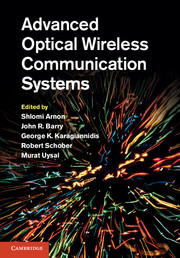Book contents
- Frontmatter
- Contents
- List of contributors
- Part I Outlook
- Part II Optical wireless communication theory
- Part III Unique channels
- 8 Modeling and characterization of ultraviolet scattering communication channels
- 9 Free-space optical communications underwater
- 10 The optical wireless channel
- 11 Hybrid RF/FSO communications
- Part IV Applications
- Index
10 - The optical wireless channel
from Part III - Unique channels
Published online by Cambridge University Press: 05 June 2012
- Frontmatter
- Contents
- List of contributors
- Part I Outlook
- Part II Optical wireless communication theory
- Part III Unique channels
- 8 Modeling and characterization of ultraviolet scattering communication channels
- 9 Free-space optical communications underwater
- 10 The optical wireless channel
- 11 Hybrid RF/FSO communications
- Part IV Applications
- Index
Summary
Introduction
Infrared (IR) indoor optical wireless (OW) potentially combines the high bandwidth availability of optical communications with the mobility found in radio frequency (RF) wireless communication systems. So although IR is currently overshadowed by a multitude of home and office RF wireless networking schemes, it has significant potential when bandwidth demand is high. Compared to an RF system, OW offers the advantageous opportunity for high-speed medium- to short-range communications operating within a virtually unlimited and unregulated bandwidth spectrum using lower-cost components. Furthermore, OW systems may be securely deployed with immunity to adjacent communication cell interference because the signal radiation cannot penetrate opaque barriers such as walls. Low transceiver costs, coupled with rapid deployment and compatibility with the existing optical fiber communication systems mean that OW is an attractive alternative when fiber deployment is difficult [1], [2]. Moreover, band-width congestion in the RF domain has led to the installation of optical hotspots in public buildings and application-specific OW hotspots can be integrated into future office designs [3]. Optical wireless communication has attracted considerable attention from the academic community. From its short-distance, low-speed origins [4], OW has become a viable addition to communication systems with promising prospects, having passed the 155 Mbps indoor landmark during the 1990s [5]. In recent years, techniques such as multispot diffusion (MSD) [6], angular diversity [7], and rate adaptive modulation [8] have been adopted as will be discussed later in this chapter.
- Type
- Chapter
- Information
- Advanced Optical Wireless Communication Systems , pp. 240 - 272Publisher: Cambridge University PressPrint publication year: 2012
- 3
- Cited by



